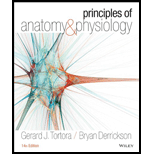
Concept explainers
On what basis are joints classified?
To review:
The basis on which the joints are classified in the human body.
Introduction:
A joint can be defined as the region of contact between the cartilage and the bone or between two bones. Flexible connective tissues hold the two or more bones together to allow movement along with better stability. These joints perform different functions based on their location and tasks.
Explanation of Solution
The joints are classified in two ways based on their structure or anatomical characteristics and function or types of movement permitted.
From a structural point of view, the joints are classified based on the kind of connective tissue, which binds the bones and the absence or the presence of the synovial cavity. Three types of joints based on the structure are as follows:
Fibrous joints: In this type, the bones are held together by the help of the dense irregular type of connective tissues that is rich in collagen fibers. There is an absence of synovial cavity in this joint type.
Cartilaginous joints: In this type, the bones are held together by cartilages. There is an absence of synovial cavity in this joint type.
Synovial joints: In this type, the bones forming the joint are encapsulated in a structure known as a synovial joint. The bones forming this joint are attached by dense and irregular type of connective tissue consisting of the articular capsule and some accessory structures like the ligaments.
From the functional point of view, the joints are classified by degree of movement permitted by the joint. The three types of joints based on the functional aspect are as follows:
Synarthrosis: In this type, the two bones are attached in such a way that there are absolutely no movements in the joint.
Amphiarthrosis: In this type, the bones are attached in such a way that the bones are slightly movable.
Diarthrosis: In this type, the bones are attached in such a way that the bones are allowed freedom of movement.
Thus, the joints are classified based on their structure and function.
Want to see more full solutions like this?
Chapter 9 Solutions
Principles of Anatomy and Physiology
- ✓ Details Draw a protein that is embedded in a membrane (a transmembrane protein), label the lipid bilayer and the protein. Identify the areas of the lipid bilayer that are hydrophobic and hydrophilic. Draw a membrane with two transporters: a proton pump transporter that uses ATP to generate a proton gradient, and a second transporter that moves glucose by secondary active transport (cartoon-like is ok). It will be important to show protons moving in the correct direction, and that the transporter that is powered by secondary active transport is logically related to the proton pump.arrow_forwarddrawing chemical structure of ATP. please draw in and label whats asked. Thank you.arrow_forwardOutline the negative feedback loop that allows us to maintain a healthy water concentration in our blood. You may use diagram if you wisharrow_forward
- Give examples of fat soluble and non-fat soluble hormonesarrow_forwardJust click view full document and register so you can see the whole document. how do i access this. following from the previous question; https://www.bartleby.com/questions-and-answers/hi-hi-with-this-unit-assessment-psy4406-tp4-report-assessment-material-case-stydu-ms-alecia-moore.-o/5e09906a-5101-4297-a8f7-49449b0bb5a7. on Google this image comes up and i have signed/ payed for the service and unable to access the full document. are you able to copy and past to this response. please see the screenshot from google page. unfortunality its not allowing me attch the image can you please show me the mathmetic calculation/ workout for the reult sectionarrow_forwardIn tabular form, differentiate between reversible and irreversible cell injury.arrow_forward
- 1.)What cross will result in half homozygous dominant offspring and half heterozygous offspring? 2.) What cross will result in all heterozygous offspring?arrow_forward1.Steroids like testosterone and estrogen are nonpolar and large (~18 carbons). Steroids diffuse through membranes without transporters. Compare and contrast the remaining substances and circle the three substances that can diffuse through a membrane the fastest, without a transporter. Put a square around the other substance that can also diffuse through a membrane (1000x slower but also without a transporter). Molecule Steroid H+ CO₂ Glucose (C6H12O6) H₂O Na+ N₂ Size (Small/Big) Big Nonpolar/Polar/ Nonpolar lonizedarrow_forwardwhat are the answer from the bookarrow_forward
 Human Biology (MindTap Course List)BiologyISBN:9781305112100Author:Cecie Starr, Beverly McMillanPublisher:Cengage Learning
Human Biology (MindTap Course List)BiologyISBN:9781305112100Author:Cecie Starr, Beverly McMillanPublisher:Cengage Learning Anatomy & PhysiologyBiologyISBN:9781938168130Author:Kelly A. Young, James A. Wise, Peter DeSaix, Dean H. Kruse, Brandon Poe, Eddie Johnson, Jody E. Johnson, Oksana Korol, J. Gordon Betts, Mark WomblePublisher:OpenStax College
Anatomy & PhysiologyBiologyISBN:9781938168130Author:Kelly A. Young, James A. Wise, Peter DeSaix, Dean H. Kruse, Brandon Poe, Eddie Johnson, Jody E. Johnson, Oksana Korol, J. Gordon Betts, Mark WomblePublisher:OpenStax College Biology 2eBiologyISBN:9781947172517Author:Matthew Douglas, Jung Choi, Mary Ann ClarkPublisher:OpenStax
Biology 2eBiologyISBN:9781947172517Author:Matthew Douglas, Jung Choi, Mary Ann ClarkPublisher:OpenStax Fundamentals of Sectional Anatomy: An Imaging App...BiologyISBN:9781133960867Author:Denise L. LazoPublisher:Cengage Learning
Fundamentals of Sectional Anatomy: An Imaging App...BiologyISBN:9781133960867Author:Denise L. LazoPublisher:Cengage Learning





